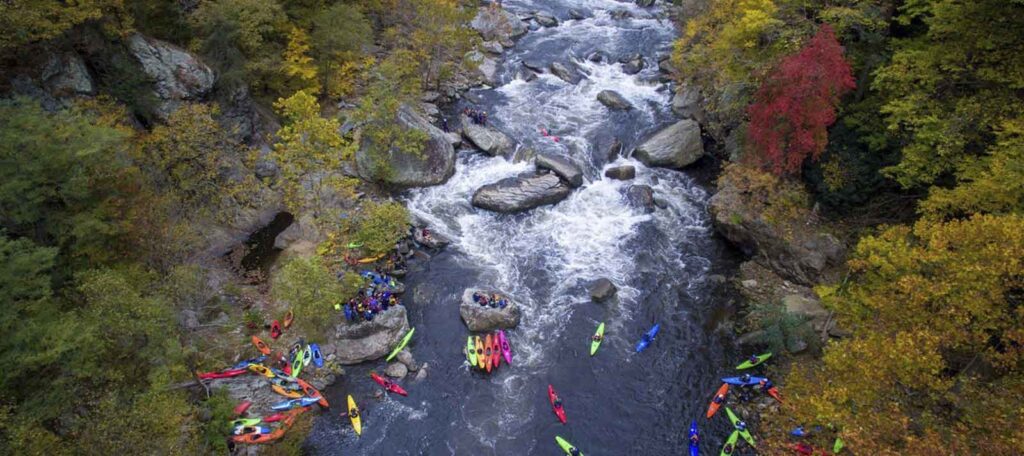The unassuming wetland is easily overlooked. After all, they often aren’t majestic like mountain lakes or fun-filled like beloved city riverwalks. But these understated terrains are hidden powerhouses that purify clean water, protect communities from flood damage, and provide habitat for a wide array of species. Among those, the hunter’s, the birder’s, and animal lovers’ delight: waterfowl.
Many of these wetlands form within floodplains, low-lying lands along rivers that naturally flood. The transformation comes quickly after a storm. What was once a dry or muddy landscape quickly comes alive as flood water flows over the land, tempting mallards, pintails, and waterfowl of all kinds to flock to these vital habitats to feast on nutrient-rich seeds and small aquatic creatures, rebuilding the fat reserves that fuel their long migrations. The shallow water creates easy feeding grounds and sheltered havens to rest between flights. Waterfowl, like so many other floodplain-dependent species, have evolved their life cycles to the natural flood pattern.
Unfortunately, more than ninety percent of floodplains in the lower 48 have been disconnected or degraded, contributing to more than half of wetlands being lost, and they continue to disappear at an alarming rate. Each acre drained means fewer places for birds to land and fewer natural floodplains to buffer nearby communities from floods.
One of the main governmental agencies that can make or break the health of our nation’s floodplain wetlands — and the services they provide for humans and waterfowl — is the Federal Emergency Management Agency. This agency’s choices on paper can shape what survives after the next storm, from homes kept out of harm’s way to wetlands where life thrives.

Let’s Stay In Touch!
We’re hard at work for rivers and clean water. Sign up to get the most important news affecting your water and rivers delivered right to your inbox.
3 FEMA programs that impact floodplains, wetlands, and waterfowl
1. National Flood Insurance Program
NFIP offers flood insurance to reduce the financial risk to flood-prone homeowners. It covers flood events typically not covered by homeowner’s insurance. For homeowners to be eligible for the NFIP, a community must put in place minimum standards that guide where and how floodplains are developed. The program relies on FEMA flood maps that show where flooding is most likely and to shape how and where we build.
When construction occurs in floodplain wetlands, the wetlands are commonly drained and filled to make way for homes and roads. Local communities then lose the natural flood protection healthy wetlands offer, and waterfowl lose their habitat. Communities that go above and beyond the minimum standards to keep floodplains open for nature to do its job, storing floodwater and providing space for wildlife, can enroll in the Community Rating System (CRS).
CRS rewards communities with lower flood insurance rates when they take extra steps to build away from high-risk areas and conserve wetlands within floodplains, creating a long-term incentive to protect these irreplaceable landscapes. This allows protected floodplains to become seasonal havens where shallow waters brim with ducks and geese. Beyond prevention, FEMA also works to restore floodplains that have already been lost.
2. Hazard Mitigation Grant Program
The Hazard Mitigation Grant Program helps communities recover from floods and reduce future flood risk through projects like home buyouts and floodplain restoration. Funding becomes available to states, local communities, and tribal governments after the president declares a disaster. When implementing voluntary buyouts, local communities use FEMA funding to purchase flood-prone properties and remove the high-liability buildings. This begins the process of potentially allowing floodplains to recover and come back to life. But the decisions that communities make next are important.
Once FEMA buys out the properties, the agency encourages the land to be managed for natural floodplain and wetland restoration, but does not carry out the restoration work itself. Instead, local governments and community partners decide how each lot is cared for. When the land is left as mowed grass, its ecological value fades. When the land is restored with native plants and reshaped to hold water, it becomes a flourishing wetland again, reviving migratory bird habitat.
3. Pre-Disaster Mitigation Program
FEMA doesn’t just help communities improve their flood resilience after a flood; the Pre-Disaster Mitigation Program can take on acquisitions and other flood mitigation projects before the flood happens. In recent years, PDM got a huge boost with the creation of the Building Resilient Infrastructure and Communities program, which has unfortunately been rolled back under the current Administration.
Through BRIC, FEMA started funding more natural flood-management strategies called nature-based solutions, including programs that reconnect and revitalize floodplains, which create the shallow pools and marsh vegetation that migrating waterfowl rely on each spring and fall.
Advocating for FEMA policies that work with nature by giving rivers room to flood without inundating property and by allowing storm drainage to settle helps support our feathered friends. As storms grow stronger, FEMA can help implement common-sense limits on risky development to avoid draining and destroying our valuable wetlands.
In the stillness of a morning wetland, you can see what’s at stake: a living landscape that protects us as surely as we protect it. Across the country, wetlands are vanishing every year. Now is the time to protect what’s left.


